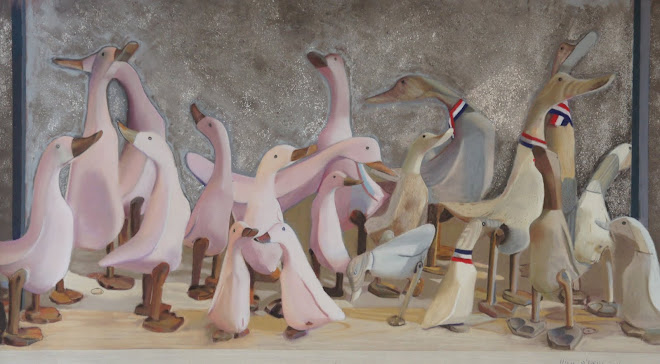 |
| Jackson's Pastels |
Wednesday, November 20, 2013
Jackson's Pastels
Jackson's Pastels are new to me (as of November 2013) are are manufactured by Jackson's Art Supplies. The full set consists of a modest 64 colours supplied in square half-sticks. There is a very useful range of neutrals in grey and in earth shades; two rather day-glow shades of pink and orange respectively; and a set of blues and greens that includes shades for blue and turquoise seas. When I checked the catalogue the full set appeared to be retailing at an astonishing £7.95 - at that price they are perfectly pitched at the beginner who wants a decent range of colours without breaking the bank. This set retails at the price of about 3 full sticks from the main pastel makers. I have given them a brief trial, and they glaze well over existing layers on paper such as Canson Mi-Teint Touch. They are much softer than Nupastel, and harder than Blue Earth - somewhere in the region of Rembrandt perhaps. There is no colour chart, so I have photographed the set for posting here. I have no information on light-fastness or pigment to binder ratio at this time.
Labels:
Jackson's Pastels
Friday, November 15, 2013
Kashkul 3
More work has been done on the bowl, and the cup and fallen fruit are connected now by the shadow of the negative space between the objects. The colour cast is due to this photo being taken in a different light to the previous one.
Labels:
Kashkul 3
Tuesday, November 12, 2013
Kashkul 2
Not a lot of progress to report on this. Some work done refining the fruit in the bowl, and the fallen physalis near the goblet is established; also some lines indicating where the base of the bowl will be painted.
Labels:
Kashkul 2
Sunday, November 10, 2013
Kashkul
The initial drawing for this painting is in the previous post. Here I have started to develop the fruit (physalis, or Cape gooseberries) in the begging bowl - or "kashkul" as I have discovered.
Technical note:The ellipse that forms the mouth of the brass cup was carefully calculated and drawn using a loop of string and a template.
I knew what the long axis and the short axis of the ellipse needed to be by scaling a photograph of the set-up to the required size and measuring it. I then applied a formula to those measurements (it in not difficult, but you can go to this website and use the online calculator: http://www.cleavebooks.co.uk/scol/callipse.htm)
First of all, to draw an ellipse with a loop of string, you need two foci (F21 and F2 above). Place pins in these foci and measure the string so that the loop is twice the length from F2 to X - this length will equal the sides of the triangle from F1 to Y to F2 and back to F1. (The short radius "b" is the distance from the centre C to Y; the long radius "a" is the distance from C to X, and is equal to the distance from Y to F1 - or Y to F2!)
Loop the string over the pins in the foci, pop a pencil in and stretch the loop fully as you draw, and you will get a perfect ellipse.For the pastel, I drew the ellipse on a spare piece of card, carefully cut it out, and used the card as a template to draw the ellipse on the support - it's safer and more accurate than drawing directly on the support.
Initial block-in of cup and fruit was done with a selection of pastel pencils, both CarbOthello and Derwent, and a few Rembrandt sticks.
Technical note:The ellipse that forms the mouth of the brass cup was carefully calculated and drawn using a loop of string and a template.
I knew what the long axis and the short axis of the ellipse needed to be by scaling a photograph of the set-up to the required size and measuring it. I then applied a formula to those measurements (it in not difficult, but you can go to this website and use the online calculator: http://www.cleavebooks.co.uk/scol/callipse.htm)
First of all, to draw an ellipse with a loop of string, you need two foci (F21 and F2 above). Place pins in these foci and measure the string so that the loop is twice the length from F2 to X - this length will equal the sides of the triangle from F1 to Y to F2 and back to F1. (The short radius "b" is the distance from the centre C to Y; the long radius "a" is the distance from C to X, and is equal to the distance from Y to F1 - or Y to F2!)
Loop the string over the pins in the foci, pop a pencil in and stretch the loop fully as you draw, and you will get a perfect ellipse.For the pastel, I drew the ellipse on a spare piece of card, carefully cut it out, and used the card as a template to draw the ellipse on the support - it's safer and more accurate than drawing directly on the support.
Initial block-in of cup and fruit was done with a selection of pastel pencils, both CarbOthello and Derwent, and a few Rembrandt sticks.
Labels:
Kashkul
Friday, November 8, 2013
On my easel
Since my last post in June I have been in France, to see (and to participate in) some pastel exhibitions and to conduct an interview for the Pastel Journal. I don't bring a full set of pastels with me, so I tend to start an underpainting with hard pastels such as Nupastels or Rembrandt, and bring the unfinished work (or ébauche) back to the studio to complete. So here are a selection of works in progress that I will post on as they progress.
Labels:
On my easel
Subscribe to:
Posts (Atom)










